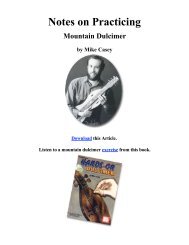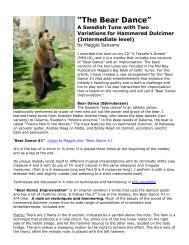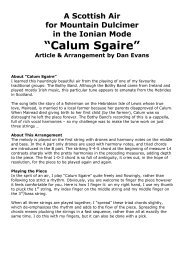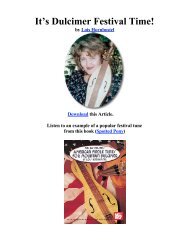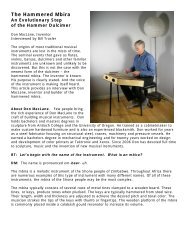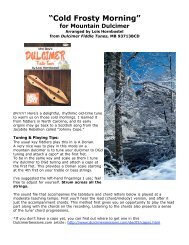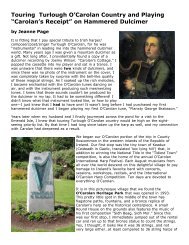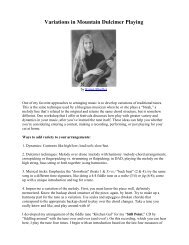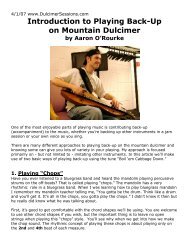Print this Article - Mel Bay's Dulcimer Sessions
Print this Article - Mel Bay's Dulcimer Sessions
Print this Article - Mel Bay's Dulcimer Sessions
You also want an ePaper? Increase the reach of your titles
YUMPU automatically turns print PDFs into web optimized ePapers that Google loves.
My <strong>Dulcimer</strong> Life<br />
by Neal Hellman<br />
Editor’s Note:<br />
Neal Hellman began playing mountain dulcimer during the 1970s - a time often referred to<br />
as the “Mountain <strong>Dulcimer</strong> Renaissance.” Many talented and creative musicians came to the<br />
instrument in <strong>this</strong> period and greatly expanded the mountain dulcimer’s playing techniques<br />
and musical possibilities for generations that have followed. Neal has been at the forefront<br />
of many of these developments.<br />
Neal has performed and taught throughout the U.S., Europe and New Zealand, and is<br />
founder and president of the highly-successful Gourd Music recording label. He is author of<br />
several books on the mountain dulcimer, including Celtic Songs & Slow Airs for<br />
Mountain <strong>Dulcimer</strong> (<strong>Mel</strong> Bay Publications 99700 - book & CD), The <strong>Dulcimer</strong> Chord<br />
Book (<strong>Mel</strong> Bay Publications 94662), and The Music of the Shakers for Mountain<br />
<strong>Dulcimer</strong> (<strong>Mel</strong> Bay Publications 96468).<br />
When asked if we could interview him for <strong>Dulcimer</strong><strong>Sessions</strong>.com, Neal responded with <strong>this</strong><br />
colorful, adventurous article...<br />
I see the beginning of my dulcimer career as the year I was born. For it was in 1948 that<br />
Jean Ritchie came to New York City as a social worker and worked at the Henry Street<br />
Settlement on the lower east side. My dad had a store just a few blocks away on Pike<br />
Street and was a member of the Henry Street Settlement. I’m sure after a night of singing<br />
folk songs he brought the dulcimer bug home with him and I caught it.
My folks were very political and my first encounter<br />
with folksongs was at the “leftist” summer camps I<br />
attended. Every day we would raise our voices and<br />
sing — “If I Had a Hammer,” “The Sloop John B,”<br />
“Children, Go Where I Send Thee,” and “This Land Is<br />
Your Land.” There were a few hundred kids all<br />
clapping as they sang and usually one lone guitar<br />
player slapping the chords and singing as loud as he<br />
or she could.<br />
In my parents’ home we mostly listened to classical<br />
music, jazz and Broadway show tunes. My mom<br />
always played Chopin and Beethoven on the piano<br />
since my folks were of Polish and German extraction.<br />
I had a brother who was five years older than me, and<br />
when he wasn’t around I’d slip into his room and listen<br />
to his records. The first time I heard the dulcimer was<br />
on the “Judy Collins #5” album, and it was Richard<br />
Fariña backing her up on “Pack Up Your Sorrows.” I<br />
remember picking up the needle and playing the cut<br />
over and over again. Neal Hellman at 16.<br />
I attended Lynchburg College in Virginia from 1966-1970. Sometime during my last year<br />
there we all made a pilgrimage to the Galax Old Fiddler’s Convention, and I grew to love<br />
the music and just the whole fun-filled folk scene.<br />
Also during my last year at Lynchburg College I began to live what folks called back then<br />
an “alternative lifestyle,” deciding that I did not want to continue my studies in Behavioral<br />
Psychology. I opted help out on a farm in Celo, North Carolina, run by a medical doctor<br />
named Fergus Pope. The idea was to provide fresh air therapy and work for abused<br />
children. It was a great notion but it just didn’t fly. So it’s July of 1970, and I have no idea<br />
what to do with my life, so I asked Dr. Pope if I could just live in the barn for a few months.<br />
One of the folks who lived on Fergus Pope’s land was a wonderful weaver (who had studied<br />
at The Penland School of Crafts) named Barbara Grenell. She owned a cherry and spruce<br />
dulcimer made by Edd Presnell and would let me play around on it. I was inspired enough<br />
to get into my little powder blue VW bug and drive up to Banner Elk to order a dulcimer<br />
from Mr. Presnell. I was truly one to be “in the spirit of the times,” and when I first laid<br />
eyes on Edd Presnell with his big old cap and long gray beard and the Blue Ridge Mountains<br />
all around his home I was awestruck. It was like Bilbo Baggins meeting Gandolf for the first<br />
time. I knew right then I was on a mission. Edd took my order and told me it might be a<br />
while and to stay in touch.<br />
I then decided to go to the state of Maine and learn how to build geodesic domes. I just had<br />
no luck with all these “alternative” projects, for <strong>this</strong> one was called off as well. So I took the<br />
ferry to Campobello Island in New Brunswick, Canada, and lived with nature for a month or<br />
so. After I left the island I began hitchhiking across Canada, and one magic bus and 3,000<br />
miles later I found myself in Vancouver, British Columbia, in 1971.<br />
And there on the street in Gastown, Vancouver, was a trio playing dulcimer, guitar and tub<br />
bass, singing one old-time song after another. The dulcimer player was John Prisland,<br />
originally from Chicago. As I took a lesson from John I wrote everything down. I decided I<br />
had found my master, and just at that time my dulcimer arrived from Edd Presnell. It was a
six string with friction pegs. It looked great, and boy was it ever hard to keep in tune.<br />
In time my girlfriend and I moved up to Squamish, British Columbia, where I wrote my first<br />
book, Life Is Like A Mountain <strong>Dulcimer</strong>, (under the light of an oil lamp) in colored pencil and<br />
crayons, in an abandoned hiker’s cabin. In arranging the music for the book I used the D-<br />
A-A, E-A-A, D-A-G, and E-A-G tunings that John Prisland had taught me.<br />
In 1973 I was deported for working without a visa and I packed up my girlfriend, large dog,<br />
dulcimer, guitar, and my manuscript and headed back to New York City. I then proceeded<br />
to blow my VW’s engine in Winnemucca, Nevada. Here’s an amazing tidbit of dulcimer<br />
minutia—when Richard and Mimi Fariña were driving from New York to California their car<br />
blew up in Winnemucca as well.<br />
In 1974, after much-to-much research, The Richmond Organization (TRO) published Life Is<br />
Like A Mountain <strong>Dulcimer</strong>. It had a little plastic “pull out” record in the back. Just before we<br />
left New York to go back to Canada, I noticed there was an ad in The Village Voice for<br />
another new dulcimer book entitled In Search of the Wild <strong>Dulcimer</strong>. As fate would have it, I<br />
soon met up with Robert Force and Albert d’Ossché, and that led to the wild and crazy<br />
Pacific Rim <strong>Dulcimer</strong> Festivals. At them I met Bonnie Carol and soon Michael Rugg, who to<br />
<strong>this</strong> day is still one of my greatest dulcimer inspirations. There was also great dulcimer<br />
scene happening in Canada—Rick Scott, Randy Rain, Walker Fanning, just to name a few.<br />
Neal Hellman teaching Robert Force & Albert d’Ossché<br />
Rick Scott’s “Lotus Eater Blues,” 1977. Photo by Bonnie Carol.<br />
Many of their arrangements appeared in my second dulcimer book, The <strong>Dulcimer</strong><br />
Songbook, published by Music Sales (Oak Publications) in 1977. Somewhere during that<br />
period of time I got together with Robert, Albert and Bonnie in Denver, Colorado, where we<br />
recorded “The Pacific Rim <strong>Dulcimer</strong> Project” album.
My favorite story from that recording is when Albert and I went up to Fort Collins with the<br />
sound engineer and we sat in with his rock band at a rock joint called “The Merry Axe.”<br />
Albert and I took the stage with the band and played a Rick Scott song called “Lotus Eater<br />
Blues.” Halfway through the tune we noticed no one was dancing. They all just stared. (I<br />
guess they were so taken with the sound of two rocking dulcimer guys that they were<br />
frozen with awe.)<br />
Albert d’Ossché, Robert Force, Michael Rugg & Neal Hellman, 1981.
Michael Rugg & Neal Hellman, 1980s<br />
In 1981 I went to the Santa Cruz Mountains for a dulcimer festival and I decided just to<br />
stay. I worked the Renaissance Fairs with Michael Rugg and we would just play standing up,<br />
our dulcimers on a counter, for many hours day. I’ve never seen anyone play Irish jigs and<br />
reels a cleanly and succinctly as Michael Rugg could.<br />
The fair was so noisy that it was hard to retune and it was during <strong>this</strong> time that I learned<br />
(mostly form Michael Rugg) how to play in D, Em, Bm, G and A out of the D-A-D tuning. A<br />
capo back then was a chopstick and a rubber band. This led to the publication of The<br />
<strong>Dulcimer</strong> Chord Book in 1981, which I’m happy to say, is still in print with <strong>Mel</strong> Bay<br />
Publications.<br />
Neal Hellman & Michael Rugg at Renaissance Fair, 1981.<br />
Around <strong>this</strong> time we all did recordings for Kicking Mule Records. Through Kicking Mule and
the Renaissance Fair I met West Coast mountain dulcimer players Janita Baker, Lance<br />
Frodsham, Randy Wilkinson, Ruth Barrett & Cynthia Smith, Holly Tannen, and Baila<br />
Dwosky.<br />
I then hit the dulcimer trail and toured around in my big green Dodge van (‘Mr. Pickle’)<br />
from 1981 – 1988. During <strong>this</strong> time I did some dulcimer books for Hal Leonard Publications<br />
and self published a number of titles as well. During my first tour in 1981 I traveled around<br />
with Alan Freeman, David Schanufer and Alan Darveaux. I also first met Lois Hornbostel<br />
during that time. I learned a lot from just watching all these folks play. I’m constantly<br />
telling my students that you can learn a lot just by being inspired by other folks’ technique.<br />
I would always make it a point to play at Jean and Lee Schilling’s dulcimer festivals. Both<br />
Jean and Lee were instrumental in promoting both the dulcimer and old-time music through<br />
their Folk Festival of the Smokies and their Mountain <strong>Dulcimer</strong> Festivals during the 80’s. I<br />
met many folks through Jean and Lee including Kim Walker, Daron Douglass and a great<br />
flatpicker dulcimer player named Nick Hallman, who taught me how to play “Fiddlin’<br />
Bagpipes.”<br />
Neal (far right) leading a parade of dulcimer players after they learned “Teddy Bears’ Picnic”<br />
from Baila Dworsky. Pacific Rim <strong>Dulcimer</strong> Kindred Gathering, Orcas Island, WA, 1985.<br />
In 1987 I decided to do an all instrumental recording entitled “Oktober County,” which in<br />
turn led to my establishing my recording label, Gourd Music. Twenty-one years and forty<br />
titles later I’m still living my life as a “mini-mogul.” I’ve learned a lot about music from my<br />
artists — William Coulter, Kim Robertson, Barry and Shelley Phillips, Joe Weed and Robin<br />
Petrie.<br />
I enjoy utilizing the dulcimer as a textural instrument; that’s why one will always find harp,<br />
oboe, English horn, cello, and guitar on all of my recordings. I love when I can blend the<br />
dulcimer, as I did on my latest recording “Emma’s Waltz,” with Swedish nyckelharpa and<br />
cello. I like to create an entire landscape of music so each time the listener experiences it
he or she might hear something different.<br />
I never try to push the instrument beyond its natural voice. For example, lately I’ve really<br />
enjoyed teaching Swedish tunes in D-A-C with the melody just on the “C” string. When I<br />
first started playing I put a lot of what I call melody chords in all my arrangements. Now I<br />
feel “less is more” and have come to enjoy the dulcimers more natural voice.<br />
I love to back up other instruments as well especially Celtic harp and a guitar tuned D-A-D-<br />
G-A-D. William Coulter, who specializes in that tuning, produced my latest recording and he<br />
appears on almost every track.<br />
That said, I truly believe any way it feels good is the way one should play the instrument. If<br />
things don’t change then things don’t grow. I enjoy all the new players of the instrument<br />
that I meet on the festival circuit these days. As they say “it’s all good”.<br />
Neal performing at Manitou Springs, CO Festival, 2003.<br />
In the future I’d like to record an album of Early Music featuring dulcimer-nyckelharpa-harp<br />
and percussion. Sort of a Mountain <strong>Dulcimer</strong>/Goth thing. I could do the white face/black<br />
lipstick thing, which would look kind of cool on a 60 year old!<br />
One last story — Somewhere between my first trip to Canada and my first dulcimer I found<br />
myself in San Cristobel, New Mexico at the Lama Foundation, where I was into Sufi<br />
dancing.<br />
After spinning around and channeling the universe for a few hours I was invited to the New<br />
Buffalo Commune for a square dance and a barbecue. There was a large dance band<br />
featuring a mountain dulcimer. It sounded so great and ignited my dulcimer passion even<br />
higher... A few years later I came to New York with my first dulcimer manuscript (the one<br />
written in colored pencils and crayon). I decided to show it to Jean Ritchie. I called her and
soon found myself on the Long Island Railroad bound for her house in Port Washington. I<br />
was actually quite nervous to meet Jean. I had on my best flowered shirt and pulled my<br />
hair back and made sure there was no food residue in my beard. I knocked on the door<br />
and when it opened I recognized Holly Tannen — the same woman who was playing<br />
dulcimer at the New Buffalo Commune! Truly I was following my bliss!<br />
Neal tunes up to play a tune with Gourd recording artist Shelley Phillips<br />
at his 60th Birthday Party (April 2008), Santa Cruz, CA.<br />
Here is my arrangement of “Breton Tune” from Cut #2 of my “Emma’s Waltz” CD. This is a<br />
piece in E minor that plays beautifully and simply using the mountain dulcimer’s natural<br />
voice. Strum traditionally across all the strings and ENJOY!<br />
Listen to Neal Hellman play “Breton Tune.”
Tune : D-A-D (capo first fret)<br />
One can also play the melody on the bass sting.<br />
& # c . ˙<br />
D<br />
A<br />
D<br />
1.<br />
0<br />
0<br />
0<br />
˙<br />
0<br />
0<br />
5<br />
œ œ œ ˙<br />
0<br />
0<br />
0 0<br />
4 5<br />
& # œ œ ˙ . œ œ ˙ .<br />
0<br />
0<br />
3<br />
0<br />
0<br />
4<br />
0<br />
0<br />
5<br />
2.<br />
0<br />
0<br />
3<br />
0<br />
0<br />
2<br />
0<br />
0<br />
6<br />
0<br />
0<br />
0<br />
0<br />
0<br />
5<br />
˙<br />
œ.<br />
0<br />
0<br />
4<br />
œ<br />
J<br />
œ œ<br />
0<br />
0<br />
5<br />
0<br />
0<br />
4<br />
˙<br />
0<br />
0<br />
0<br />
0<br />
0 3<br />
& # j<br />
œ œ ˙ œ . œ œ œ œ œ ˙ .<br />
& #<br />
0<br />
0<br />
3<br />
2.<br />
œ .<br />
0<br />
0<br />
4<br />
0 0<br />
0 0<br />
0 2<br />
œ<br />
J<br />
œ œ<br />
0<br />
0<br />
5<br />
0<br />
0<br />
4<br />
0<br />
0<br />
2<br />
Breton Tune<br />
1.<br />
0<br />
0<br />
2<br />
0<br />
0<br />
3<br />
0<br />
0<br />
4<br />
0<br />
0<br />
2<br />
œ œ ˙<br />
0<br />
0<br />
3<br />
0<br />
0<br />
2<br />
© 2007 Gourd Music<br />
0<br />
0<br />
0<br />
0<br />
0<br />
3<br />
0<br />
0<br />
4<br />
0<br />
0<br />
5<br />
Breton Dance<br />
0<br />
0<br />
2
More About the Author<br />
Neal Hellman, nationally acclaimed performer and teacher of the mountain dulcimer, has<br />
been active in performing, writing, teaching, and recording acoustic music for over 25<br />
years throughout the United States, Europe and New Zealand.<br />
Neal's latest recording, “Emma's Waltz,” is a colorful dance through traditional and<br />
contemporary acoustic music styles. Featuring many talented musicians playing<br />
compositions from Ireland, Scotland, Finland, America and France.<br />
Neal's other recordings (Gourd Music label) include:<br />
“Autumn In the Valley”<br />
“Dream of the Manatee” (with Joe Weed)<br />
“Oktober County”<br />
Dirty Linen wrote of “Oktober County”: "The material is first-rate and the musicianship is<br />
flawless;" and the Santa Cruz Sentinel said Dream of the Manatee is "just plain beautiful<br />
music. The San Jose Mercury wrote "Autumn In the Valley is<br />
well-played and impeccable engineered."<br />
He is the author of many books on the Appalachian dulcimer, including:<br />
Celtic Songs & Slow Airs for Mountain <strong>Dulcimer</strong><br />
The <strong>Dulcimer</strong> Chord Book<br />
The Music of the Shakers For Mountain <strong>Dulcimer</strong><br />
The Hal Leonard <strong>Dulcimer</strong> Method, Beatles <strong>Dulcimer</strong> Book<br />
As a teacher, Neal is regularly paid the greatest compliment possible: his festival<br />
workshops are invariably crowded with students, old and new, who appreciate his clear<br />
instructional style, varied and original repertoire, and enthusiasm for his instrument.<br />
Visit Neal’s Gourd Music website, http://www.gourd.com/NealBioWorkshops.html . He can<br />
be reached at neal@gourd.com



